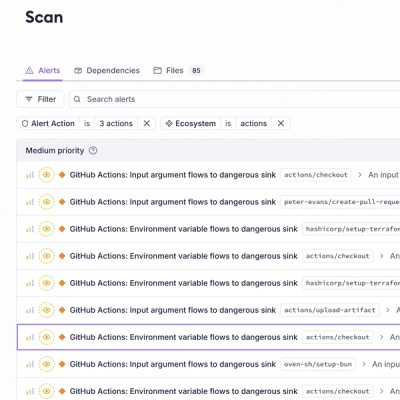
Product
Introducing Socket Firewall Enterprise: Flexible, Configurable Protection for Modern Package Ecosystems
Socket Firewall Enterprise is now available with flexible deployment, configurable policies, and expanded language support.
@zudoku/react-helmet-async
Advanced tools
Announcement post on Times Open blog
This package is a fork of React Helmet.
<Helmet> usage is synonymous, but server and client now requires <HelmetProvider> to encapsulate state per request.
react-helmet relies on react-side-effect, which is not thread-safe. If you are doing anything asynchronous on the server, you need Helmet to encapsulate data on a per-request basis, this package does just that.
New is 1.0.0: No more default export! import { Helmet } from 'react-helmet-async'
The main way that this package differs from react-helmet is that it requires using a Provider to encapsulate Helmet state for your React tree. If you use libraries like Redux or Apollo, you are already familiar with this paradigm:
import React from 'react';
import ReactDOM from 'react-dom';
import { Helmet, HelmetProvider } from 'react-helmet-async';
const app = (
<HelmetProvider>
<App>
<Helmet>
<title>Hello World</title>
<link rel="canonical" href="https://www.tacobell.com/" />
</Helmet>
<h1>Hello World</h1>
</App>
</HelmetProvider>
);
ReactDOM.hydrate(
app,
document.getElementById(‘app’)
);
On the server, we will no longer use static methods to extract state. react-side-effect
exposed a .rewind() method, which Helmet used when calling Helmet.renderStatic(). Instead, we are going
to pass a context prop to HelmetProvider, which will hold our state specific to each request.
import React from 'react';
import { renderToString } from 'react-dom/server';
import { Helmet, HelmetProvider } from 'react-helmet-async';
const helmetContext = {};
const app = (
<HelmetProvider context={helmetContext}>
<App>
<Helmet>
<title>Hello World</title>
<link rel="canonical" href="https://www.tacobell.com/" />
</Helmet>
<h1>Hello World</h1>
</App>
</HelmetProvider>
);
const html = renderToString(app);
const { helmet } = helmetContext;
// helmet.title.toString() etc…
This package only works with streaming if your <head> data is output outside of renderToNodeStream().
This is possible if your data hydration method already parses your React tree. Example:
import through from 'through';
import { renderToNodeStream } from 'react-dom/server';
import { getDataFromTree } from 'react-apollo';
import { Helmet, HelmetProvider } from 'react-helmet-async';
import template from 'server/template';
const helmetContext = {};
const app = (
<HelmetProvider context={helmetContext}>
<App>
<Helmet>
<title>Hello World</title>
<link rel="canonical" href="https://www.tacobell.com/" />
</Helmet>
<h1>Hello World</h1>
</App>
</HelmetProvider>
);
await getDataFromTree(app);
const [header, footer] = template({
helmet: helmetContext.helmet,
});
res.status(200);
res.write(header);
renderToNodeStream(app)
.pipe(
through(
function write(data) {
this.queue(data);
},
function end() {
this.queue(footer);
this.queue(null);
}
)
)
.pipe(res);
While testing in using jest, if there is a need to emulate SSR, the following string is required to have the test behave the way they are expected to.
import { HelmetProvider } from 'react-helmet-async';
HelmetProvider.canUseDOM = false;
It is understood that in some cases for SEO, certain tags should appear earlier in the HEAD. Using the prioritizeSeoTags flag on any <Helmet> component allows the server render of react-helmet-async to expose a method for prioritizing relevant SEO tags.
In the component:
<Helmet prioritizeSeoTags>
<title>A fancy webpage</title>
<link rel="notImportant" href="https://www.chipotle.com" />
<meta name="whatever" value="notImportant" />
<link rel="canonical" href="https://www.tacobell.com" />
<meta property="og:title" content="A very important title"/>
</Helmet>
In your server template:
<html>
<head>
${helmet.title.toString()}
${helmet.priority.toString()}
${helmet.meta.toString()}
${helmet.link.toString()}
${helmet.script.toString()}
</head>
...
</html>
Will result in:
<html>
<head>
<title>A fancy webpage</title>
<meta property="og:title" content="A very important title"/>
<link rel="canonical" href="https://www.tacobell.com" />
<meta name="whatever" value="notImportant" />
<link rel="notImportant" href="https://www.chipotle.com" />
</head>
...
</html>
A list of prioritized tags and attributes can be found in constants.ts.
You can optionally use <Helmet> outside a context by manually creating a stateful HelmetData instance, and passing that stateful object to each <Helmet> instance:
import React from 'react';
import { renderToString } from 'react-dom/server';
import { Helmet, HelmetProvider, HelmetData } from 'react-helmet-async';
const helmetData = new HelmetData({});
const app = (
<App>
<Helmet helmetData={helmetData}>
<title>Hello World</title>
<link rel="canonical" href="https://www.tacobell.com/" />
</Helmet>
<h1>Hello World</h1>
</App>
);
const html = renderToString(app);
const { helmet } = helmetData.context;
Licensed under the Apache 2.0 License, Copyright © 2018 Scott Taylor
FAQs
Thread-safe Helmet for React 16+ and friends
We found that @zudoku/react-helmet-async demonstrated a healthy version release cadence and project activity because the last version was released less than a year ago. It has 4 open source maintainers collaborating on the project.
Did you know?

Socket for GitHub automatically highlights issues in each pull request and monitors the health of all your open source dependencies. Discover the contents of your packages and block harmful activity before you install or update your dependencies.

Product
Socket Firewall Enterprise is now available with flexible deployment, configurable policies, and expanded language support.

Security News
Open source dashboard CNAPulse tracks CVE Numbering Authorities’ publishing activity, highlighting trends and transparency across the CVE ecosystem.

Product
Detect malware, unsafe data flows, and license issues in GitHub Actions with Socket’s new workflow scanning support.